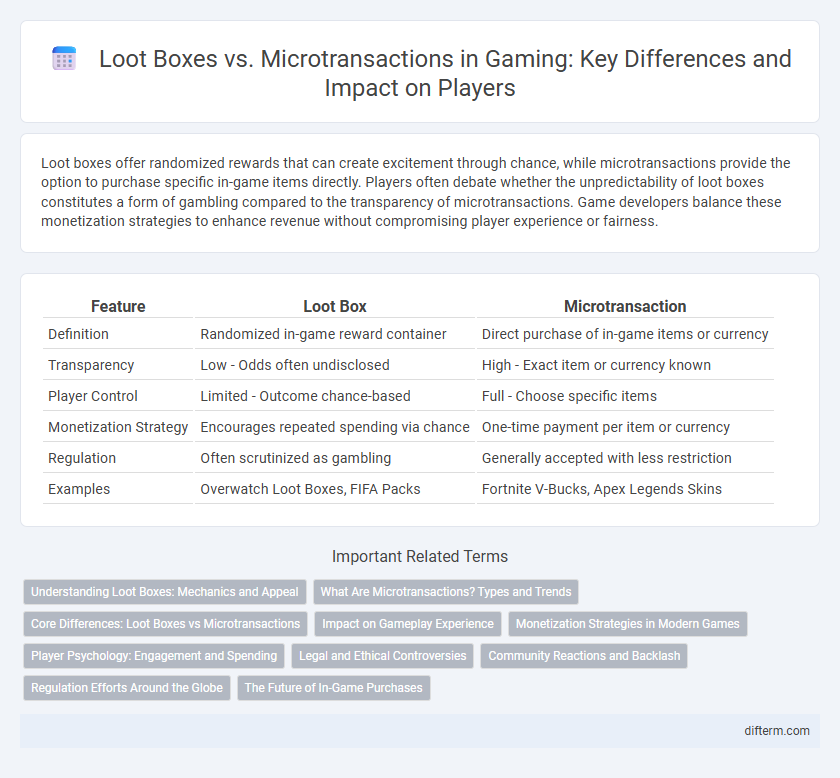Loot boxes offer randomized rewards that can create excitement through chance, while microtransactions provide the option to purchase specific in-game items directly. Players often debate whether the unpredictability of loot boxes constitutes a form of gambling compared to the transparency of microtransactions. Game developers balance these monetization strategies to enhance revenue without compromising player experience or fairness.
Table of Comparison
| Feature | Loot Box | Microtransaction |
|---|---|---|
| Definition | Randomized in-game reward container | Direct purchase of in-game items or currency |
| Transparency | Low - Odds often undisclosed | High - Exact item or currency known |
| Player Control | Limited - Outcome chance-based | Full - Choose specific items |
| Monetization Strategy | Encourages repeated spending via chance | One-time payment per item or currency |
| Regulation | Often scrutinized as gambling | Generally accepted with less restriction |
| Examples | Overwatch Loot Boxes, FIFA Packs | Fortnite V-Bucks, Apex Legends Skins |
Understanding Loot Boxes: Mechanics and Appeal
Loot boxes are randomized reward containers in games that offer players a chance to obtain cosmetic or gameplay items, often encouraging repeated purchases through the thrill of unpredictability. Their appeal lies in strategic design elements such as variable rarity levels, immediate gratification, and the psychological pull of gambling-like mechanics. Understanding these features reveals how loot boxes drive player engagement and revenue differently compared to direct microtransactions, which sell specific items without chance.
What Are Microtransactions? Types and Trends
Microtransactions are small in-game purchases that allow players to buy virtual goods or currency, often enhancing gameplay or customization options. Common types include cosmetic items, battle passes, consumables, and loot boxes, each offering varying degrees of randomness and player choice. Recent trends show a shift towards transparent pricing and cosmetic-only transactions to address consumer concerns and regulatory scrutiny.
Core Differences: Loot Boxes vs Microtransactions
Loot boxes are randomized reward containers that require players to spend money or in-game currency for a chance to receive specific items, often creating a gambling-like experience. Microtransactions allow players to purchase specific in-game content directly, such as skins, characters, or boosts, offering transparent and predictable transactions. The core difference lies in the element of randomness with loot boxes versus the guaranteed purchase of desired items through microtransactions.
Impact on Gameplay Experience
Loot boxes introduce randomized rewards that can disrupt game balance by creating reliance on chance rather than skill, often leading to frustration among players. Microtransactions, while offering direct purchases of in-game items or enhancements, may lead to pay-to-win scenarios, undermining fair competition and player progression. Both mechanics can negatively impact the gameplay experience by prioritizing monetization over player engagement and satisfaction.
Monetization Strategies in Modern Games
Loot boxes and microtransactions represent two pivotal monetization strategies in modern gaming, each leveraging psychological incentives to maximize player spending. Loot boxes offer randomized rewards that tap into gambling-like excitement, while microtransactions allow players to purchase specific items or enhancements directly, providing immediate gratification. These models significantly impact game design and player engagement, shaping revenue streams in the evolving digital gaming economy.
Player Psychology: Engagement and Spending
Loot boxes leverage randomized rewards to trigger dopamine release, creating a compulsion loop that enhances player engagement and increases spending through uncertainty and excitement. Microtransactions offer predictable purchases, appealing to players' desire for control and instant gratification, which can sustain long-term monetization by catering to diverse spending habits. Both mechanics exploit psychological triggers such as reward anticipation and social comparison to maximize player investment and revenue generation.
Legal and Ethical Controversies
Loot boxes and microtransactions in gaming face intensified legal scrutiny due to concerns over gambling-like mechanics targeting minors and lack of transparency in odds disclosure. Regulatory bodies across the EU and the US increasingly demand stricter consumer protection measures, including age verification and clearer labeling. Ethical debates highlight the potential for exploitative monetization practices that may encourage addictive behaviors, prompting calls for industry-wide reforms.
Community Reactions and Backlash
Loot boxes have faced intense community backlash due to their perceived gambling-like mechanics and lack of transparency, sparking widespread debates about ethical game design. Microtransactions, while more accepted when offering cosmetic or non-pay-to-win items, still attract criticism for encouraging pay-to-progress models that can fracture player trust. Gamers frequently voice concerns on forums and social media, demanding clearer regulations and more player-friendly monetization methods in gaming.
Regulation Efforts Around the Globe
Regulation efforts around the globe increasingly target loot boxes and microtransactions due to concerns over gambling-like mechanics and consumer protection, with countries like Belgium and the Netherlands banning or restricting these features in video games. Authorities in the United States and United Kingdom have introduced guidelines requiring transparency and age restrictions to mitigate risks for younger players. Ongoing debates emphasize the need for standardized international policies to address the financial and ethical implications of in-game purchases.
The Future of In-Game Purchases
Loot boxes and microtransactions continue to shape the future of in-game purchases by influencing player engagement and revenue models. Game developers are increasingly adopting transparent microtransaction systems to enhance player trust and comply with evolving regulations. Emerging trends favor fair, cosmetic-only purchases over randomized loot boxes to create balanced gaming experiences and maintain community satisfaction.
Loot Box vs Microtransaction Infographic

 difterm.com
difterm.com